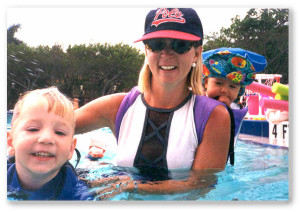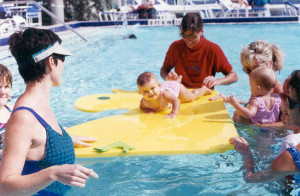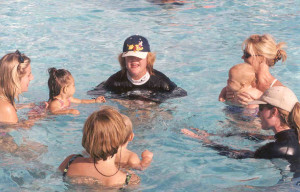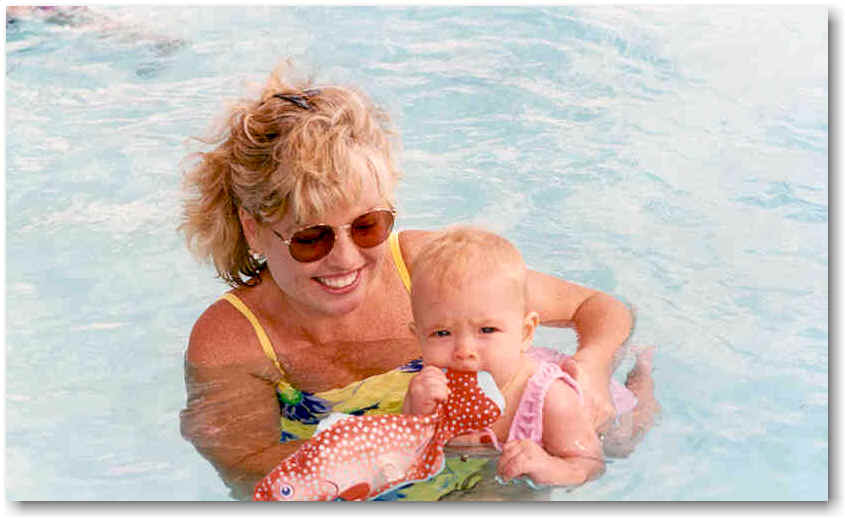![]()
![]()
![]()
[notify_box font_size=”13px” style=”blue”]This page is intended to help you recognize a gentle, child-centered program in your part of the world. Identifying those programs that are sensitive to the feelings of the child, celebrating their spirit, not breaking it. The criteria listed on this page all contribute to creating an optimal learning environment. The closer you are able to approach these ideals, the more natural and smooth it will be for your child to initiate their transition from land, into this new and exciting liquid world. Seek out a positive curriculum and teacher, group classes, parents in the water with their child, warm/clean water and frequently offered classes, if possible. If a positive, baby-friendly program is not available in your area and you have elected to safely and slowly teach you own baby how to swim, the following guidelines should be considered as you orient your child to the water. You may wish to utilize our award winning video series Diaper Dolphins as a teaching and water safety resource.[/notify_box]
Keep It Fun!

We have observed that the slower you teach, the faster and better your child will ultimately learn. Through creating an optimal learning environment, children progress by assimilating skills at their natural rate of learning. This transformation from land to water is as on going evolution, with expanding abilities and the opportunity for new skill development each year. In this way our Diaper Dolphins grow in harmony with the water, it becomes like a second home. Babies love colorful toys, songs, games and puppets. As the saying goes “A watched pot never boils.” Your baby should look forward to coming to class.
Group Classes


Peer learning serves as a very influential motivator. Positive group energy can actually supercede the challenging behaviors some youngsters may be experiencing as they enter the “Terrible Twos” period of their development. This group effect teamed with an innovative and interactive age appropriate curriculum all contribute to maintaining the child’s interest and participation in class. An ideal opportunity is also established for social interaction between the children as well as the moms and dads. This format is just plain fun and takes pressure to perform off the child. This results in a more natural learning environment, allowing skills to unfold at each child’s unique rate.
If such a group class is not available in your area, you may choose to have your child taught in a private lesson format. Private lessons can be synonymous with accelerated skill acquisition, due to perceived cost factors or one on one constant pressure for visible day to day achievement. This can translate into a hurried and intensive situation, at the expense of the child’s well-being and comfort in the water.
We highly suggest that if you do choose private lessons, that they it be with-in a “baby-friendly” philosophy, as professed by such baby swimming pioneers as Virginia Hunt Newman. Methods such as Virginia’s allow the child to unfold, with no pressure, no tears, with a gradual long term perspective, while working at the child’s pace. Limit your water time to 30 minutes.
If a child-centered,” baby friendly” program is not available in your area and you wish to fly solo and teach your own child, perhaps you could invite several friends to join you at your pool. You may find it beneficial to utilize our Diaper Dolphin Videos series as a teaching resource, just remember to keep your time in the water fun, consistent, long term and safe.
Participating Parent

Positive, pro-active, nurturing parents, participating in the water with their child allows for security, comfort, and bonding. No one knows a child better than their own parent. Who better than a parent (or significant other) to help guide their young Diaper Dolphin toward water confidence, aquatic ability and especially over all child development. Directly involving the parent in the class also creates the opportunity to safely reinforce skills and play with their children while in their home pool.
Ideal Water Conditions

Infants and toddlers (and their parents) are most comfortable in warm water especially when the children are in the water adjustment stage. We aim for a 90ºF (32ºC) to 92ºF water temperature. We have observed that babies orient best to the class when the air temperature is at least 80ºF or above, with little or no breeze. However, these ideal conditions are not always possible. If the air is in the high 80’s, some babies are able to tolerate a water temperature as low as 84ºF. Several adaptations can be implemented to make this unique swimming adventure comfortable for the babies. For example, in the winter months we experience cooler air temperatures (for infants) even here in South Florida. When the air temperature reaches the lower 70’s (we still swim out outdoors) our young students wear pint sized wet suits to help maintain body warmth. Some of our babies will also wear latex or silicone (these are great as they don’t stick to your hair) swim caps which help to maintain body heat loss through the head. Also, take care to keep your child’s shoulders under water and avoid sitting on the pool edge wet on cooler days. In all cases if you notice that your child is becoming chilled or see their lips begin to quiver, it’s time to stop your lesson for the day.
Before entering the pool remove the babies regular diaper and clean the baby. New technologies and design have revolutionized baby pool wear. Now widely available are snug fitting swim pants, made of nylon, licra or cotton cloth. Kimberly Clark has recently introduced a snug fitting disposable pool pant. Infant/toddler swim suits are easily worn over the protective pool pant.
The deck, changing areas and facility should be clean, safe and family friendly.
Class Frequency
In order to give developmentally appropriate advantage to those students new to swimming (Water Adjustment and Basic Skills), we recommend that you initially attend class at least 4x per week for 4 weeks.* This is truly the best and fairest way to introduce you and your child to the wonderful and exciting transition from land to water. Continuity and repetition greatly enhances your child’s ability to adapt to this new situation and unique liquid environment, especially in regard to water adjustment and breath control. Our 31 years of experience teaching thousands of babies has taught us that “a little bit on a lot of days” (minimum 4x per week in the beginning stages) is far more effective and fluid than once or twice per week because it conforms to the natural infant/toddler learning cycle. This can eliminate potential frustration on the part of both parent and child and creates an ideal opportunity for “baby friendly” learning. Most students will be adjusted to the water, comfortably submerge on the breath holding cue and swim a few feet after one month (with-out the use of force). Those children (or parents) apprehensive, timid or demonstrating discomfort with water poured on their face, may take two months or more to adapt at their pace. Once children can safely and happily swim a few feet, attending class 4x per week is not as critical. We have observed from this point forward, that while 4x per week is optimal, family scheduling can make this difficult, in this case a minimum of swimming at least two times per week is suggested.
*However, to accommodate working parents who are unable to attend four classes per week, during the initial water adjustment and breath control phase, playing in the bath can help to bridge the gap between classes at the pool. Just remember to exert a hardy dose of patience and keep it fun.
[notify_box font_size=”13px” style=”blue”]Also be sure to check out Questions Helpful in Selecting a Baby Friendly Program[/notify_box]